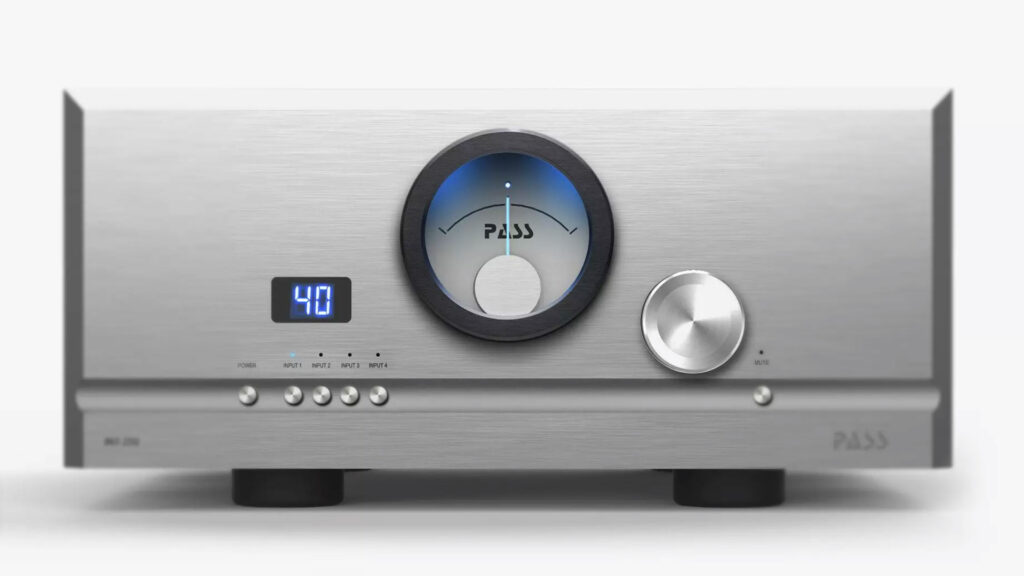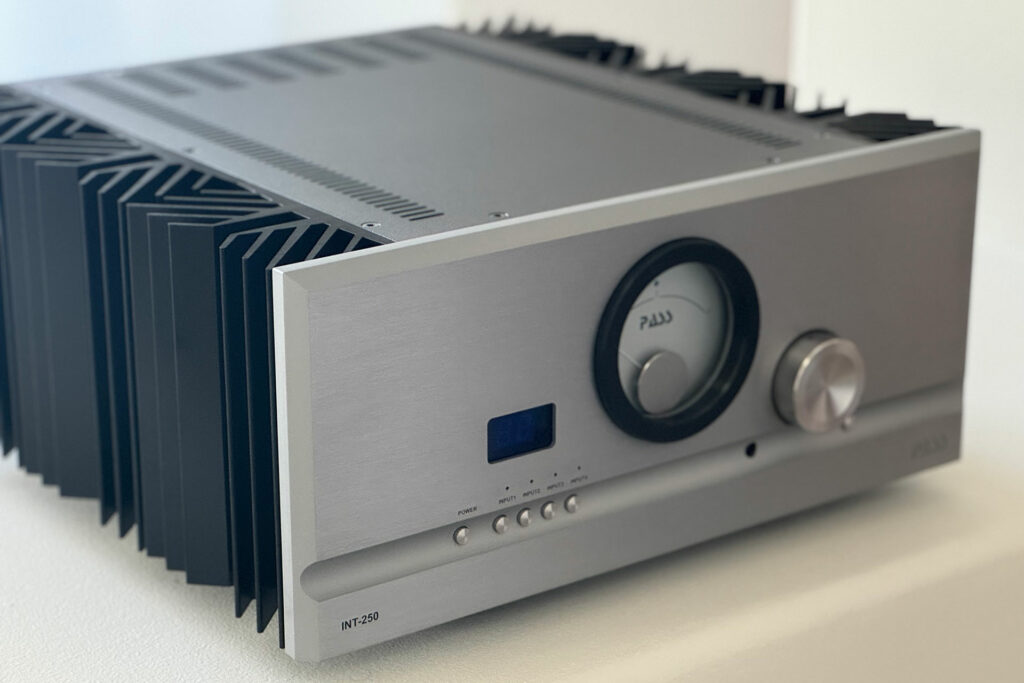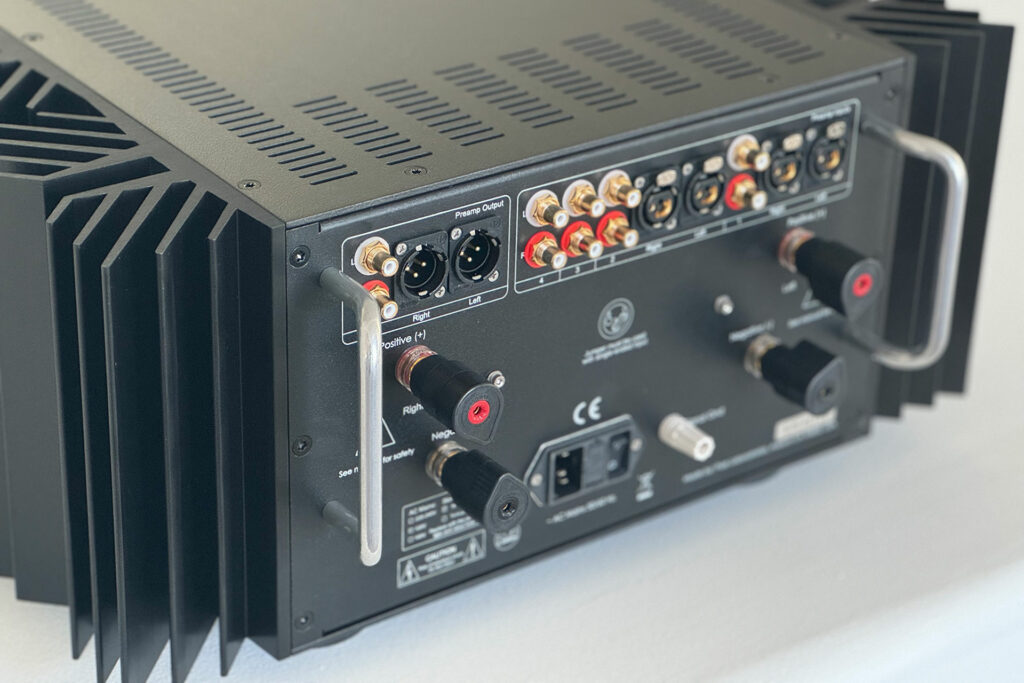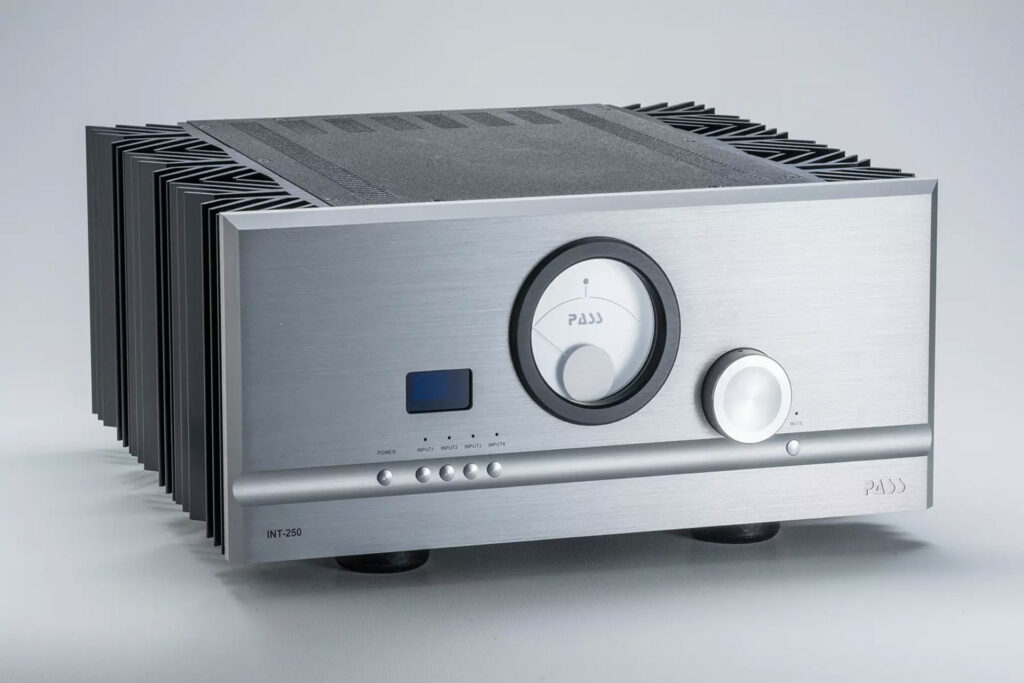One of the most affordable and, in this case, powerful ways to rock your audiophile system is to look for a high-end integrated amp for your power needs. The Pass Labs INT-250 is one of many strong options in the $10,000-plus price category the delivers the best of both worlds, being a Nelson Pass designed .8 series amplifier design with a Wayne Colburn preamp section, all in one massive chassis. With enough power to drive tricky electrostats or even speakers that get into some weird impedances, the Pass Labs INT-250 is up for the challenge.
What is missing from the value proposition is a digital section and/or a phonostage. Those are designed to be added to your system as unique components, whereas other integrated amps try to throw the kitchen sink at the feature set. We gave the Product of the Year Award to the NAD C 3050 for its retro-good looks, paired with literally every feature that we could dream of under the hood, for about $1,400. The Pass Labs INT-250 is whole other way of looking at an integrated amp. It has a more simplistic, performance-over-features strategy that is designed to hang with very serious separate components. Can the Pass Labs INT-250 hang? I’ve had some very cool speakers to try them out on lately, so let’s find out.

What Makes the Pass Labs INT-250 So Special?
- The Pass Labs INT-250 is a monster of an integrated amp. I don’t mean just physically, but in terms of its overall power. It is hard not to see the design footprint of the recently reviewed Pass Labs X250.8 power amp as that Class-AB design is basically what you are getting for power here, and that ain’t too shabby.
- Wayne Colburn is a massively underrated preamp designer, and the Pass Labs INT-250 has a great preamp included. I got to spend some serious time with the Pass Labs XP-22 during my review and, to this day, I regret taking it over to Greg Handy’s place, because it now lives there. He upgraded from the more affordable but still quite awesome Pass Labs XP-12 to the Pass Labs XP-22 as its two-chassis preamp has a killer power supply and is able to resolve amazing levels of detail. I would peg the preamp in the Pass Labs INT-250 more like an XP-12 than an XP-22 but, together with the best of a Pass Labs X250.8, this makes for one hell of an integrated amp on paper.
- The industrial design of the Pass Labs INT-250 is stunning. I am a sucker for gauges. However, my reference Pass Labs XA-25 amp, a more entry-level power amp from their Class-A series, has no gauge, which is fine for my current system, as it lives behind a door, so I can’t see the amp glowing in its glory when it is playing. The Pass Labs INT-250 doesn’t skimp on the audio jewelry. The volume knob is fantastic to touch. The buttons have a well-designed feel. Everything about the amp feels high-end, high-performance, and expensive.
- The Pass Labs INT-250 comes with a remote that can be useful, but isn’t super sexy, as compared to, say, the latest Crestron or something fancy from the CI world.
- Class-AB output can be as high as 400-plus watts, but into eight ohms, you are rocking 250 watts per channel, which is enough to drive any of today’s best speaker designs without breaking a sweat.
- There are both balanced (XLR) and unbalanced (RCA) inputs. My Pass Labs XA-25 has only unbalanced inputs, which is a little limiting, but that’s how they keep the price down on the XA-25, which is a very good thing.

Why Should You Care About the Pass Labs INT-250 Integrated Amp?
At these prices, the Pass Labs INT-250 is a bit of a bargain, but it is also in the same price range as very respectable separate audiophile power amps and preamps. The value of being able to upgrade those components is what kept me from investing in a higher-end integrated amp over the years. One major draw of the INT-250 is its simplicity. For some systems having so many components, cables and power needs is just over-complicated. While this isn’t a “just add speakers” solution, it is more consolidated and simplified. You can add a nice streamer/DAC and a pair of speakers, and be rocking a very high-end system. I’ve heard the smaller Pass Labs integrated amp with an old Oppo BDP-203 and a pair of Sandy Gross-era GoldenEar speakers at a recent AXPONA show, and they were making dollar-for-dollar the best sound in any of the rooms with a system that you could aspire to actually own. In the case of the Pass Labs INT-250, we’ve got a lot more power and features to play with, assuming that you have the budget. That should be compelling for many audiophiles out there these days.
Some Things You Might Not Like About the Pass Labs INT-250
- The Pass Labs INT-250 is a huge audiophile component that weighs over 100 pounds. You must consider where you are going to put this behemoth before you get going with a setup. You are going to need something more substantial than some IKEA for the Pass Labs INT-250 and, by all means, this product commands that level of investment for its installation.
- Heat is always an issue with Nelson Pass’ designs and, while the Pass Labs INT-250 doesn’t cook quite like my Pass Labs XA-25, it does get hot. The big heat sinks on the side of the amp help dissipate heat, but a good nine to 12 inches of space above the Pass Labs INT-250 would be well-advised for long-term installation success.
- Although a fancier one would run up the bill, the remote is a bit of a brick. I used unity gain and then my Roon or BlueOS app to change volume, which was a pretty nifty solution.

Listening to the Pass Labs INT-250 Integrated Amp …
My reference system for the Pass Labs INT-250 review includes Bowers & Wilkins 802 D4loudspeakers, a much less powerful but “more Class-A” Pass Labs XA-25 power amp, an Anthem STR stereo preamp, a Bricasti M3 DAC and a BlueSound Node. I’ve been playing with the Bricasti M5 streamer, but I pulled that out to keep things more familiar. However, I am very encouraged with what I am hearing from the Bricasti M5. Check back in for that review soon, as that’s my next unit up.
One of my favorite demos that I’ve been using in all of my recent reviews is Beyoncé’s killer cover of The Beatles’ “Blackbird” (QoBuz). The melody is about as familiar as it gets, but the arrangement highlights both Queen B’s iconic vocals, as well as lush overdubs from a cost-no-object COVID-era recording session. On the Pass Labs XA-25, there isn’t much color, but there is perhaps a little bit of sweetness. With the Pass Labs INT-250, you get the benefit of a Wayne Colburn-designed preamp (think: XP-12-ish), which brings in more openness but that isn’t what caught my attention. What was special was the headroom. The vast reserve of power of the Pass Labs INT-250 made things sound so palpable. The percussive taps on the pick guard had more dynamics. If you will allow a car analogy, today’s fast European cars come with turbocharged V6s power plants that output a lot of power, but when you compare them to a larger displacement engine, things just feel different. There’s more torque. That’s what the American-made Pass Labs INT-250 sounds like. As they say in NASCAR, there’s no replacement for displacement. Perhaps that’s true for power amps, too.
On “Hot Pants” from The Best of James Brown (QoBuz), I noticed so much more space than what I was used to. You could hear the jingle-jangly guitar in its own space, with the horns having a resolved yet purposefully muted sound. The Hardest Working Man in Showbiz’s vocals stood out in front of the soundstage in a way that when you closed your eyes, you felt like you were in the studio. The vast reserve of power made you want to step on the gas a bit with the volume, which is a little dangerous, but also a lot of fun.
Looking into more produced progressive rock tracks, I had a blast listing to “Red Sector A” from Rush’s Grace Under Pressure (AIFF 1440). I love the music from my teenage years, and this is one of my favorites, as I have quite the penchant for prog-rock. With the Pass Labs INT-250, the whole musical presentation had a bit more heft or palpability. It sounded more rock and roll. As compared to the few Gallium Nitride amps that I’ve been blessed enough to play with recently, that heft is why the big power of the Pass Labs INT-250 is a benefit. Don’t get me wrong, while Nelson and I don’t see eye to eye on semiconductor amps, I view him as perhaps the best amplifier designer in audiophile history, and the Pass Labs INT-250 delivers that bass spank that many of us like. It delivers a lot of headroom that on the Bowers & Wilkins 802 D4s gave that “in the mastering lab” sound, without the “I bought this amp for $100,000 from Switzerland” price tag.
Will the Pass Labs INT-250 Integrated Amp Hold Its Value?
My overall issue with integrated amps is that you merge your investment for your preamp and amp (and in some cases DACs, room correction and streamer) all in one box, thus your upgrade path is complicated and a little harder to liquidate. With that said, the Pass Labs INT-250 is a juggernaut and more than enough power and control for any modern speaker. Nelson’s legacy (ADCOM, Forte, Threshold, Sony, First Watt, and more) goes without saying. Trust me, friends, your money is safe invested in a Pass Labs INT-250.

What is the Competition for the Pass Labs INT-250 Integrated Amp?
NAD’s M33 at $4,999 from the Master Series was reviewed by Brian Kahn and comes with a comparable 200 x 2 watts, but has a lot more features, including BluOS, DAC, Internet connectivity, and more. The NAD is more of the Swiss Army knife-type product, and more designed for the “just add speakers” client, versus the very serious audiophile who wants the performance of separates but without the separate chassis. The Pass Labs INT-250 has a more spank with its Class-AB amp and 50 watts more power.
If we are comparing cool factor, the Dan D’Agostino Progression Integrated Amp at almost $21,000 is more comparable to the Pass Labs INT-250, but close to double the price. Dan designs gorgeous audiophile electronics that crush with the same kind of visceral impact that I love in the Pass Labs INT-250. The Pass Labs INT-250 looks great, but the Dan D Progression is even more exotic with its steampunk industrial design.
Taking more of the NAD approach, but with more of a cost-no-object design (and pricing) philosophy, the Gryphon Diablo 333 is an exotic monster. I’ve had the chance to hear this beast at a number of recent audiophile shows, and it delivers that white truffle effect, meaning that, for around $30,000, you get a little taste of something that is normally much more expensive when bought in its entirety. The Gryphon unit has a DAC, which makes it a little different than the Pass Labs INT-250. The disparity in performance would be up to you to put a value on. The disparity in price versus the Pass Labs INT-250 is gigantic.
Final Thoughts on the Pass Labs INT-250 Integrated Amp …
The Pass Labs INT-250 is a world-beater of an integrated amp that delivers the sex appeal of a true audiophile component, with the highest level of audiophile pedigree. When I suggest that a $12,600 integrated amp is a “value,” I know that some audiophiles will roll their eyes, but when you look at the competition in totally bad-ass integrated amps, and it is easy to see the value of the Pass Labs INT-250, and how it can be the power behind a truly great audiophile system.
Delivering sexy good looks, powerful dynamics, seemingly unlimited headroom and wonderful detail, the Pass Labs INT-250 is a winner as well as a value.




If I could commit a crime for ANY one integrated amp on the planet- This is it! I’ve always wanted this amp.
The Dartzeel is the other, but I will never be able to afford that unit.
Thank you for reviewing the amp.
It maybe splitting, hairs but I think it is important if mentioning or contrasting against your XA-25 it’s pointed out the XA-25 is a single ended, Push Pull design. Hence, most likely why only RCA outputs although some add XLR out of convenience, or confusion. The X30.8 as example has similar power rating with a differentially balanced design where a XLR connection arguably would be preferred, especially in use with other differentially balanced components. It would just help to exhibit how the XA-25 is unique. To my knowledge the XA-25 is a one of a kind in the Pass Labs or First Watt line-up.
For clarification the X30.8 has XLR inputs as does all the X series that are differentially balanced. The XLR’s do come with the jumper pin to allow use of the RCA inputs also featured.
The XA stuff is balanced.
My XA-25 is not.